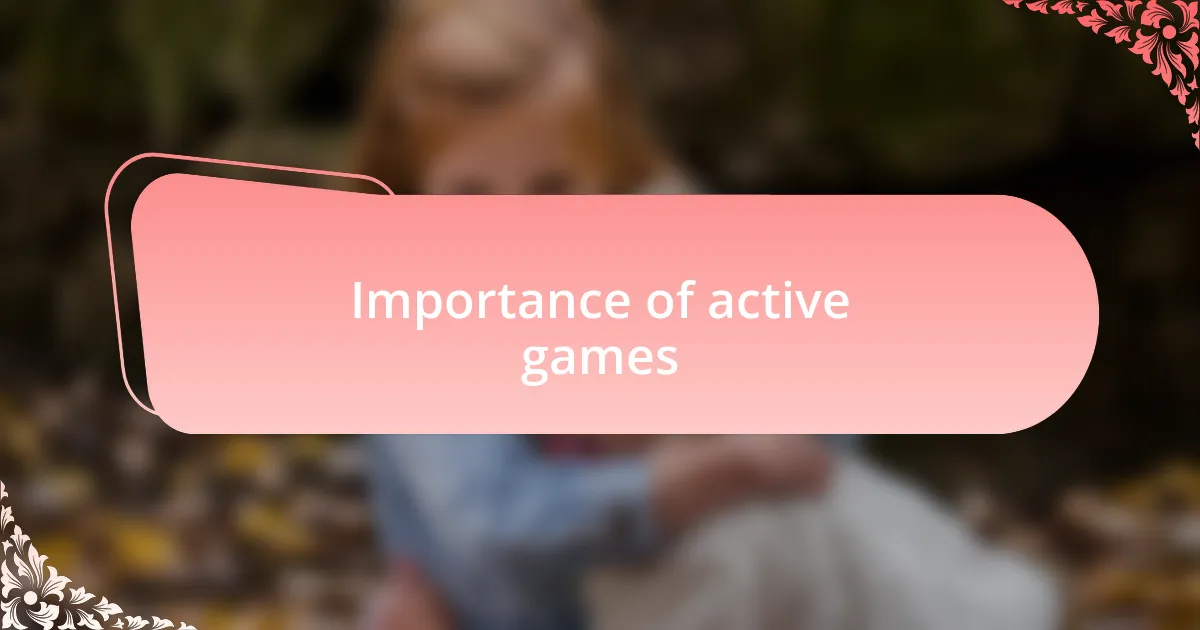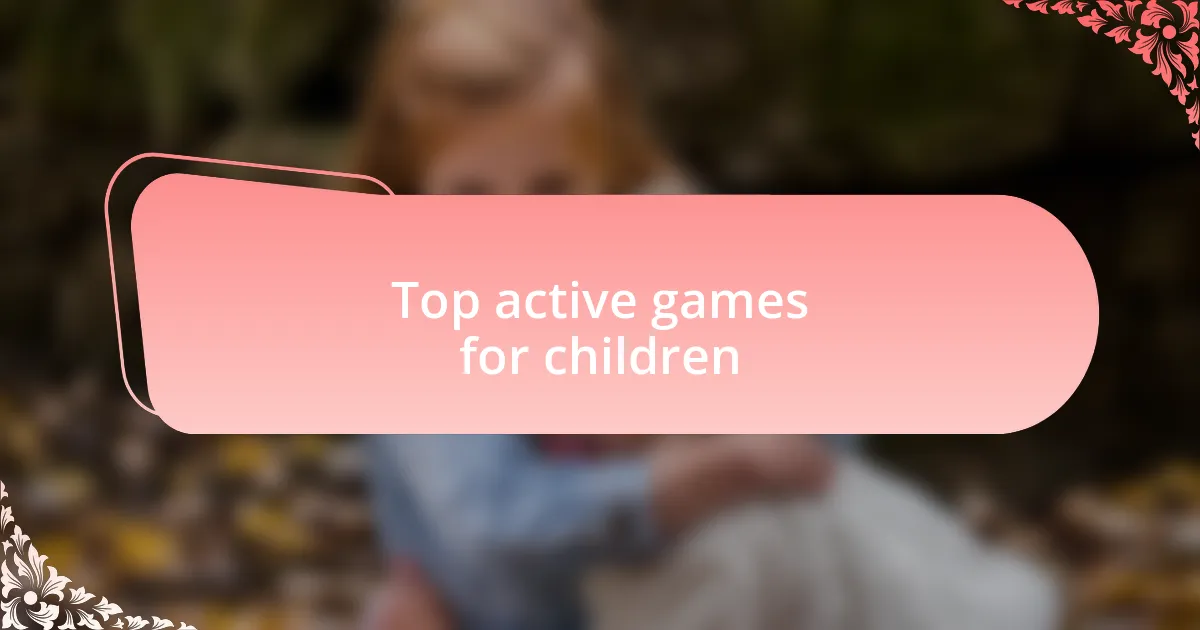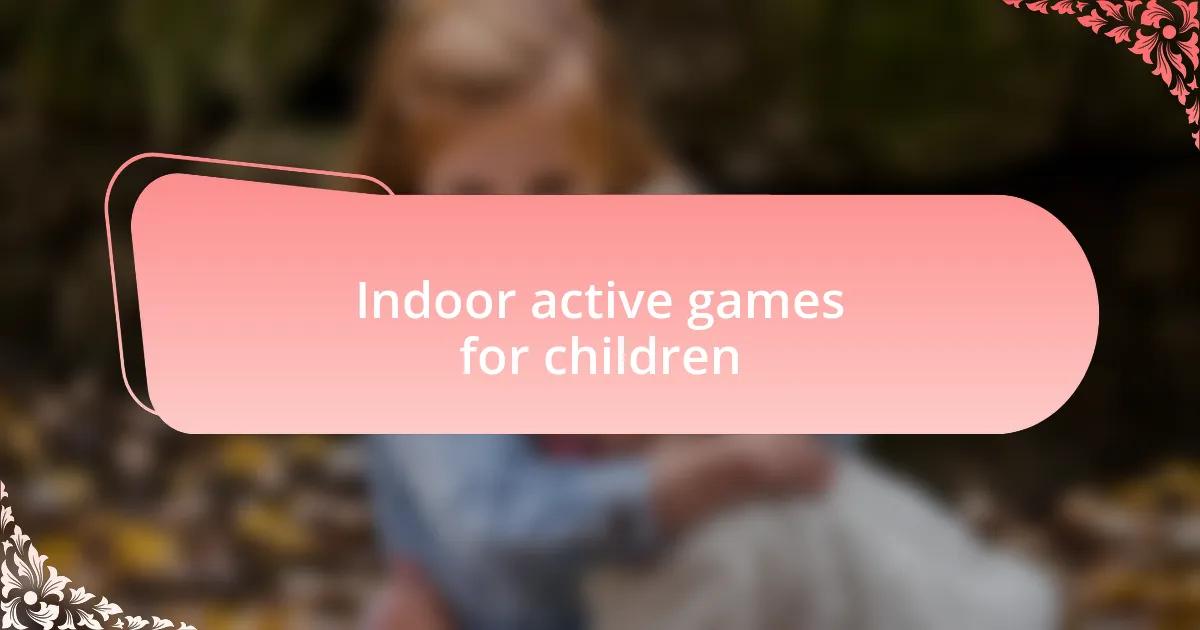Key takeaways:
- Child health support focuses on nurturing the physical, mental, and emotional well-being of children through active play and holistic initiatives.
- Active games significantly improve physical health, boost mental health by alleviating anxiety, and foster social skills and teamwork.
- Regular physical activity enhances cognitive function and self-esteem, while also developing a connection with the environment.
- Different age groups benefit from tailored games, ranging from simple activities like “Simon Says” for younger children to strategic games like “Capture the Flag” for preteens.

Child health support overview
Child health support encompasses a range of initiatives and practices aimed at nurturing the physical, mental, and emotional well-being of children. From nutritional guidance to promoting active play, the goal is always to lay a solid foundation for a lifetime of healthy habits. I remember when my nephew was little; he would light up when we played games in the park, which sparked in him a love for outdoor activities. That’s the essence of child health support — creating joyful experiences that promote movement and engagement.
One critical aspect is the importance of balance in activities. Have you ever noticed how some kids instantly gravitate toward screen time, often at the expense of physical play? I think back to the times we would challenge each other to see who could run the fastest or climb the highest on the playground. Those moments not only strengthened our bodies but also deepened our bonds and built resilience. This highlights the need for parents and caregivers to intentionally carve out time for active games in their children’s lives.
Moreover, embracing a holistic approach to child health support means considering emotional health alongside physical health. I often find that when children participate in games, they not only exercise but also learn to manage emotions and build teamwork skills. How often do we overlook the emotional growth that comes from simply running around and laughing with friends? Those moments shape their ability to handle both success and failure later in life. It’s a beautiful reminder of how integral play is to a child’s overall development.

Importance of active games
Active games play a pivotal role in developing children’s physical health. I remember a summer when my friends and I formed teams for capture the flag in our backyard. The laughter, the sprinting, and the thrill of competition had us moving non-stop. It wasn’t just fun; it was a workout disguised as play, showing me early on how exercise can be both enjoyable and essential.
Engaging in active games also boosts mental health significantly. Reflecting on my own childhood, I found that my mood lifted when I participated in physical activities. Have you ever noticed how a good game of tag can turn a gloomy day into one filled with smiles? The energy released during active play creates a natural high that can help combat feelings of anxiety or stress, leading children to a healthier emotional state.
Additionally, active games foster social skills and teamwork. I recall days spent playing soccer, where I not only honed my skills but also learned how to communicate effectively with teammates. Isn’t it fascinating how a simple game can teach children critical life lessons about cooperation and shared goals? These experiences lay the groundwork for building relationships and navigating social situations throughout their lives.

Benefits of physical activity
Physical activity has profound benefits that extend beyond just physical fitness. For instance, I still vividly remember those endless afternoons spent jumping rope with friends; it didn’t just get my heart pumping, but it also enhanced my coordination and balance. Have you ever realized how mastering a new skill, like a jumping routine, can boost a child’s self-esteem? Those small victories during playtime can create a sense of accomplishment that carries over into other areas of life.
Moreover, regular engagement in active games can significantly improve cognitive function. I often recall how my focus was sharper after a session of running around outside. It’s as if each game helped clear the fog in my mind. Isn’t it interesting how physical challenges can make mental challenges seem so much easier? This connection between physical activity and brain health is something every parent should consider when encouraging their children to play.
Lastly, physical activity often fosters a deeper connection to the environment. I remember exploring the woods during games of hide and seek, developing not just my physical prowess, but also a sense of adventure and curiosity about nature. Have you ever seen how immersive play can ignite a child’s interest in their surroundings? This type of engagement not only promotes fitness but also nurtures a lifelong appreciation for the world outside.

Top active games for children
When I think about the top active games for children, tag stands out as a timeless classic. I remember feeling invincible as I dashed around, desperately avoiding capture and using my quick thinking to outsmart my friends. Have you ever noticed how exhilarating it is to master the art of dodging? It reinforces not just agility but also teamwork and strategy as kids learn to communicate and plan their escapes together.
Another favorite of mine is the age-old game of capture the flag. The rush I felt when sprinting toward the opposing team’s territory is something I can still recall vividly. This game challenges not only physical abilities but also encourages children to engage in strategy and cooperation. Isn’t it fascinating how such games help kids develop critical thinking skills while having the time of their lives?
Lastly, I remember the excitement of playing hopscotch, where each jump felt like a small triumph. I loved how simple it was, yet how many skills it developed—balance, coordination, and even counting. Can you recall how satisfying it was to finally reach the end of the grid without a single stumble? It’s a game that can be played anywhere, promoting both physical fitness and social interaction.

Games for different age groups
When it comes to younger children, simple games like “Simon Says” are perfect. I remember playing this with my younger cousins, and their delight in following instructions was infectious. It’s not just fun; it helps develop listening skills and body awareness. Have you ever seen a child giggle as they try to freeze in a silly pose? It’s those little moments that make such games invaluable.
For kids aged six to ten, games that involve a bit more structure, like “Obstacle Course,” can be incredibly rewarding. I’ve set up courses in my backyard using everyday items, like hula hoops and cones, and watched as they took on each challenge with increasing confidence. This kind of play nurtures their physical abilities while also encouraging problem-solving skills. Isn’t it amazing how a lawn chair can become a towering hurdle in their imagination?
When we look at preteens, “Capture the Flag” evolves again, incorporating more strategic elements. I’ve seen friendships form and strengthen as groups collaborate to outwit each other. The thrill of sprinting back to your base with the flag in hand is a rush that transcends age. Does it ever surprise you how, even at this age, teamwork shines through in high-energy games like these? It’s a testament to how play fosters essential life skills in kids of all ages.

Indoor active games for children
When you’re stuck indoors, finding active games that keep children engaged can be a challenge. One of my favorites is the “Indoor Scavenger Hunt.” I simply create a list of common household items and let the kids race against the clock to find them. Watching their excitement as they dash from room to room in search of items is pure joy. Have you ever seen a child light up at discovering a hidden treasure? It’s a fantastic way to foster teamwork as siblings or friends cheer each other on.
Another fun option is “Balloon Volleyball.” This game transforms any living room into a lively arena. I remember playing it at a family gathering, where our laughter echoed off the walls as we tried to keep the balloon from touching the ground. It’s a simple concept, yet watching everyone dive and stretch not only keeps them active but also creates memorable moments of joy and camaraderie. How often do we get such wholesome entertainment from something as light and airy as a balloon?
For those rainy days, “Dance Party” is a surefire hit. I often curate a playlist of upbeat songs and let the kids unleash their energy through dance. It’s remarkable how they express themselves while getting a great workout simultaneously. Have you ever noticed how music can transform the atmosphere? It invigorates the space, turning a mundane day into a vibrant one filled with laughter and movement. It’s a reminder that staying active can be as simple as letting loose and enjoying the rhythm together.

Outdoor active games for children
When the sun shines, there’s nothing quite like a game of “Capture the Flag” to get kids moving outdoors. I remember one summer afternoon when we organized a neighborhood game. The excitement of sneaking around, strategizing, and working as a team was palpable. Have you ever felt the thrill of a close chase? It’s those high-energy moments that create unforgettable memories.
Another favorite is “Obstacle Course.” I often set up a variety of challenges using everyday items like hula hoops and cones in the backyard. Watching my kids navigate the course, encouraging each other at every turn, reminds me how active play promotes both physical and social skills. How incredible is it to see children conquer challenges while having fun? It’s a simple yet effective way to boost their confidence and fitness levels.
Then there’s “Jump Rope Challenges.” I’ve witnessed the sheer joy on their faces when they manage to master new skipping tricks. One day, we created a friendly competition, and as they cheered each other on, it turned into a delightful display of collaboration and resilience. Have you ever noticed how something as simple as a jump rope can spark creativity and boost self-esteem? Moments like these are vital for their development, proving that outdoor games can enrich childhood in countless ways.